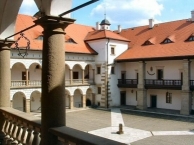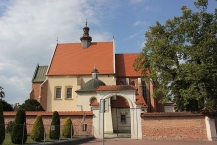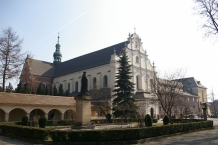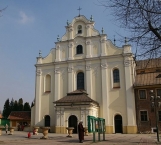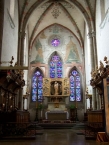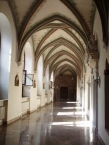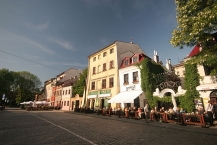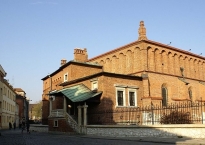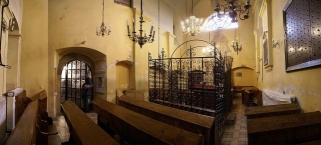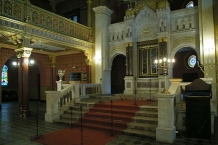Cycle Route Greenway Amber Trail
Actions
![]()
Please wait - map data are loading
Added on 14 May 2013,
last edited by biroto-Redaktion on 11 Jan 2021
Actions
Cycle route metrics
Total distance in km
251
Information about rights to the gps-track data | |
|---|---|
Rights owner | OpenStreetMap and Contributors + biroto-Redaktion (biroto.eu) |
Rights characteristic / license | Contains information from OpenStreetMap, which is made available here under the Open Database License(ODbL) |
Link to the description of the license | |
GPX file taken from | |
GPX file uploaded | by biroto-Redaktion on 11 Jan 2021
|
Track points in total
3.892
Track points per km (avg)
16
Start/endpoint
Start location
Nowy Korczyn, Świętokrzyskie Voivodeship, PL (175 m NHN)
End location
District of Námestovo, Region of Žilina, SK (610 m NHN)
Beds4Cyclists, worth visiting and infrastructure
Name and address
Latitude / Longitude
Phone
Fax
Mobile
Type of accommodation
Rating for cyclists
Route km
Dist. to route
Elevation
87 km
0,0 km
195 m
Information about copyright | |
|---|---|
Rights owner | |
Rights characteristic / license | cc0: Public Domain no Rights reserved |
Link to the description of the license | |
Image taken over from | https://commons.wikimedia.org/wiki/File:Zamek-niepolomice.jpg |
Image has been uploaded | by ThimbleU on 30 Nov 2015
|
Information about copyright | |
|---|---|
Rights owner | |
Rights characteristic / license | by-sa: CREATIVE COMMONS Attribution-ShareAlike |
Link to the description of the license | |
Image taken over from | https://commons.wikimedia.org/wiki/File:Niepolomice_kosciol_10000_Meczennikow_6.jpg |
Image has been uploaded | by ThimbleU on 30 Nov 2015
|
Niepołomice [ɲɛpɔwɔˈmʲit͡sɛ] is a town in southern Poland, situated in the Lesser Poland Voivodeship (since 1999), previously in Kraków Voivodeship (1975–1998). It is situated on the Vistula River, and belongs to Kraków
on the verge of a large virgin forest (Polish: Puszcza Niepołomnicka - Niepołomice Forest
). There is a 14th-century gothic hunting castle in town built by Casimir III, as well as a conservation center for wisents (Polish: Żubry) nearby.
Information about copyright | |
|---|---|
Rights characteristic / license | by-sa: CREATIVE COMMONS Attribution-ShareAlike |
Link to the description of the license | |
Input taken over from: |
Wikipedia contributors, 'Niepołomice', Wikipedia, The Free Encyclopedia, 8 July 2015, 19:50 UTC, <https://en.wikipedia.org/w/index.php?title=Niepo%C5%82omice&oldid=670564214> [accessed 30 November 2015] |
taken over / edited on | 30 Nov 2015
|
taken over / edited by |
|
108 km
0,1 km
Information about copyright | |
|---|---|
Rights owner | |
Rights characteristic / license | by-sa: CREATIVE COMMONS Attribution-ShareAlike |
Link to the description of the license | |
Image taken over from | https://commons.wikimedia.org/wiki/File:Krakow_Mogila_Opactwo_Cystersow_20080309_1222_2618.jpg |
Image has been uploaded | by biroto-Redaktion on 06 Dec 2015
|
Information about copyright | |
|---|---|
Rights owner | |
Rights characteristic / license | by-sa: CREATIVE COMMONS Attribution-ShareAlike |
Link to the description of the license | |
Image taken over from | https://commons.wikimedia.org/wiki/File:Krakow_Mogila_klasztor_20080309_2608.jpg |
Image has been uploaded | by biroto-Redaktion on 06 Dec 2015
|
Information about copyright | |
|---|---|
Rights owner | |
Rights characteristic / license | by-sa: CREATIVE COMMONS Attribution-ShareAlike |
Link to the description of the license | |
Image taken over from | https://commons.wikimedia.org/wiki/File:Mogiła_-_Klasztor_-_Ołtarz.JPG |
Image has been uploaded | by biroto-Redaktion on 06 Dec 2015
|
Information about copyright | |
|---|---|
Rights owner | https://commons.wikimedia.org/w/index.php?title=User:Kanonkrajoznawczy |
Rights characteristic / license | by-sa: CREATIVE COMMONS Attribution-ShareAlike |
Link to the description of the license | |
Image taken over from | https://commons.wikimedia.org/wiki/File:Klasztor_Mogiła_-_krużganki.JPG |
Image has been uploaded | by biroto-Redaktion on 06 Dec 2015
|
Mogiła Abbey (Polish: Opactwo Cystersów w Mogile; Latin: Abbatia B.M.V. de Clara Tumba) is a Cistercian monastery in the Nowa Huta District of Kraków
, Poland. The abbey was founded in 1222 by the Bishop of Kraków, Iwo Odrowąż. The religious complex was built for religious reasons as well as for prestige. It was the largest and most impressive church in medieval Poland after Wawel Cathedral
, and served as the Odrowąż family's burial place until the 16th century.
The architectural complex includes the stuccoed Polish Gothic church, the Basilica of the Holy Cross (Polish: Bazylika Krzyża Świętego), which serves as the Parish Church of St. Bartholomew the Apostle as well as the abbey church for the monks. There is also the Polish Renaissance-style abbot's palace, built around 1569, as well as the red-brick monastery, with a broad inner courtyard, outbuildings, vegetable garden, greenhouse, etc.
Under the reign of Henry I the Bearded, the Duke of Silesia, a community of monks was brought in from Lubiąż Abbey to Mogiła by Odrowąż around 1219, to commence the construction of the brand new church in his diocese. He granted them a village by the Vistula River
, close to his residence in the capital. The monastic community, consisting of the 13 professed monks mandatory for an independent monastery, moved in around 1225, although the expansion of the abbey continued for years to come. The Mogiła Abbey was confirmed by the Roman Curia through a papal bull signed by Pope Gregory IX on 9 June 1228. In Latin, the monastery still retains its name of Clara Tumba (Bright Tomb), a name derived from two local toponyms. There is an ancient barrow, called Wanda Mound, within a mile of the monastery site; and the name of the site of the monastery, originally the village of Mogiła
, translates as "tomb" in Polish.
In 1241 the abbey was ransacked in the course of the Mongol invasion of Poland. It was rebuilt and the abbey church was consecrated in 1266 by Bishop Jan Prandota. It was later consumed by fire in 1447. It was ravaged again in the 17th century by the invading Swedish army. The abbey was destroyed and its entire resident population was killed by the Swedes, except for two monks whose lives were spared. The structure was renovated numerous times. The Baroque façade of the monastery church was added in 1779–80, based on a design by Franz Moser.
The abbey church was promoted in 1970 by Pope Paul VI to the rank of a Minor Basilica, and visited by Pope John Paul II, who celebrated Mass for 200,000 people in a nearby open field in 1979.
Information about copyright | |
|---|---|
Rights characteristic / license | by-sa: CREATIVE COMMONS Attribution-ShareAlike |
Link to the description of the license | |
Input taken over from: |
Wikipedia contributors, 'Mogiła Abbey', Wikipedia, The Free Encyclopedia, 18 January 2015, 23:25 UTC, <https://en.wikipedia.org/w/index.php?title=Mogi%C5%82a_Abbey&oldid=643122715> [accessed 6 December 2015] |
taken over / edited on | 06 Dec 2015
|
taken over / edited by |
|
118 km
1,7 km
213 m
118 km
0,5 km
202 m
Information about copyright | |
|---|---|
Rights owner | |
Rights characteristic / license | by-sa: CREATIVE COMMONS Attribution-ShareAlike |
Link to the description of the license | |
Image taken over from | https://commons.wikimedia.org/wiki/File:Szeroka,_Kraków,_2009.jpg |
Image has been uploaded | by biroto-Redaktion on 31 Aug 2016
|
Information about copyright | |
|---|---|
Rights owner | https://commons.wikimedia.org/w/index.php?title=User:Barbara_Maliszewska |
Rights characteristic / license | by-sa: CREATIVE COMMONS Attribution-ShareAlike |
Link to the description of the license | |
Image taken over from | https://commons.wikimedia.org/wiki/File:06660vik_Krakowski_Kazimierz._Foto_Barbara_Maliszewska.jpg |
Image has been uploaded | by biroto-Redaktion on 31 Aug 2016
|
Information about copyright | |
|---|---|
Rights owner | https://commons.wikimedia.org/w/index.php?title=User:Barbara_Maliszewska |
Rights characteristic / license | by-sa: CREATIVE COMMONS Attribution-ShareAlike |
Link to the description of the license | |
Image taken over from | |
Image has been uploaded | by biroto-Redaktion on 31 Aug 2016
|
Information about copyright | |
|---|---|
Rights owner | |
Rights characteristic / license | by-sa: CREATIVE COMMONS Attribution-ShareAlike |
Link to the description of the license | |
Image taken over from | https://commons.wikimedia.org/wiki/File:Krakow_Synagoga_Tempel_20071111_1141_2144.jpg |
Image has been uploaded | by biroto-Redaktion on 31 Aug 2016
|
Kazimierz is a part of Old Town district of Krakow ![]() in Poland. Before World War II, it was a Jewish district.
in Poland. Before World War II, it was a Jewish district.
Understand
Kazimierz was a city founded in 1335 by Polish King Casimir III on an island on the Vistula river. In the 19th century the river branch between Kazimierz and Old Town was dried and built over. After the end of 15th century Jews became an important part of Kazimierz' population as they fled Krakow because of antisemitism. The division of Kazimierz is still visible, the western part with pl. Wolnica and St. Michael's Church (Skałka) was Christian and the eastern with pl. Nowy and ul. Szeroka was Jewish.
Kazimierz became one of Krakow's districts in 1791. In 1943 all Krakowian Jews were forced by the Nazi occupiers to move to the ghetto located in Podgórze and later transported to death camps. After the war uninhabited houses in Kazimierz were populated by a poor and sometimes criminal element, so Kazimierz gained the reputation of the 'bad neighbourhood' in Krakow.
In the 1990s, however, a popular annual Jewish Culture Festival started, the city renovated old synagogues, and new cafes, clubs and galleries opened. In the early 21st century, the district underwent a typical gentrification process and these days rents are really high and small galleries and eateries have started to give way to luxurious hotels.
See
Museums and galleries
- Ethnographic Museum, Town Hall building, Plac Wolnica 1, 'Esterka' building, ul. Krakowska 46, ☎ +48 12 430 5575. Located in the old 15th century Kazimierz town hall. 5 - 9 zł, Mondays closed.
- Museum of City Engineering (Muzeum Inżynierii Miejskiej), ul. św. Wawrzyńca 15, ☎ +48 12 421 1242 wew.100. It is located in old tram sheds and on the grounds of former gasworks and powerplant. It has exhibitions on the history of Polish automotive, public transportation, radio and television, household and office appliances industries. The museum is well prepared for younger visitors. 5 - 8 zł, Mondays closed, Tuesdays free.
- Centre for Jewish Culture (Judaica Foundation), ul. Meiselsa 17, ☎ +48 12 430 6449. Exhibitions, concerts, seminars and workshops on Jewish culture. There is also a cafe (with roof terrace!) and a great antiquarian bookshop located in the basement.
- Galicia Jewish Museum, ul. Dajwór 18, ☎ +48 12 421 6842. 10AM-6PM. The Galicja Museum in Kazimierz houses an exhibition of photographs with explanations in Polish and English. These are recent photographs of locations around Poland associated with the Holocaust. Some are places where massacres occurred; most show old synagogues and Jewish cemeteries with comments about how respectfully (or not) these places are now preserved. The museum also has a bookstore and coffee shop and arranges coach trips to Auschwitz. Tickets are 15 zł or 8 zł with a student discount.
- Jewish Community Centre, ul. Miodowa 24, ☎ +48 12 370 5770. Exhibitions, events, lectures on Jewish culture and language lessons.
Synagogues and prayer houses
Before 1939 there were several dozen synagogues in Kazimierz. After the war most of them were destroyed or converted to residential or public use buildings and their previous function is, after remodeling, imperceptible. Some are still functioning as prayer houses or museums:
- ⊙Old Synagogue, ul. Szeroka 24, ☎ +48 12 422 0962. Built sometime during the 15th century, the synagogue is the oldest still standing synagogue in Poland. It was ransacked by the Nazis during World War II and was renovated between 1956 and 1959. Currently, it serves as a museum documenting Jewish life in Kraków. Adults: 8 zł. Discounted: 6 zł.
- ⊙Remuh Synagogue (Synagoga Remuh), ul. Szeroka 40. Su. - F. 9AM - 6PM. The synagogue and adjoining Jewish Cemetery with the grave of Moses Isserles. Adults: 5 zł. Discounted: 2 zł.
- ⊙Tempel Synagogue, ul. Miodowa 24. Built in 1860 - 1862. Reform synagogue that is open to the public. Since it's an operational synagogue male visitors are expected to wear yarmulke and women should dress somewhat conservatively and have their shoulders covered. During the Nazi occupation, the synagogue was used as a horse stable, but was eventually rededicated to its religious mission. Inside, the synagogue is beautiful, it has a monumental example of Aron Kodesh made from Carrara marble and 43 stained glass windows.
- Bne Emuna Synagogue - corner of ul. Meiselsa and pl. Nowy. The building of Judaica Foundation – Centre For Jewish Culture.
- Chewra Thilim Synagogue - corner or ul. Meiselsa and Bożego Ciała. Today an exhibition space with rare, well preserved polychrome.
- Izaak Synagogue (Isaak Jakubowicz Synagogue) - corner of ul. Kupa and Izaaka. Built in 17th century was considered the most beautiful in Krakow, after the war it was a theater, warehouse and sculpture workshop. Since the 1980s it has been renovated and serves as Jewish Education Centre. Since 2007 it had also been used for religious purposes.
- Kowea Itim le-Tora Synagogue - ul. Józefa 42. Built in 1810 and renovated in 1912 (these dates are written in Stars of David put on the facade). Devastated by Nazis the building became residential after the war.
- Kupa Synagogue - ul. Warschauera 8. Also called Hospital or Poor Synagogue as these were the people it mostly served. After the war it was a warehouse and shoe factory, today it is one of the venues for religious ceremonies and cultural festivals, Jewish Culture Festival among others.
- Mizrachi Synagogue - ul. Kupa 18. Built in 1930s right next to Izaak Synagogue. Since the 80s it serves as a Jewish Culture Centre.
- Wolf Popper Synagogue - ul. Szeroka 16. Was one of the most splendid buildings in Kazimierz, devastated during the Nazi occupation. Today a cultural centre with workshops on dance, art classes, lectures, film screenings, etc.
- ⊙High Synagogue - ul. Józefa 38. Called "high" because the prayer room is on the second floor (this is the only example of that kind in Poland). Third synagogue built in Kazimierz, in Renaissance style. It's in bad condition but conservators are working on the building. It is open to public and photo exhibitions are sometimes put there.
- ⊙Great Mikveh - ul. Szeroka 6, building from 1567 rebuilt at the beginning of 20th century, today Klezmer Hois restaurant and rooms. Ritual bath in the basements, around 40 steep stairs below ground level, can be visited.
Churches
- ⊙Bożego Ciała Church (Corpus Cristi Church) — corner of ul. Bożego Ciała and pl. Wolnica. Gothic Church erected by Kazimierz the Great in 1340. The greatest Italian artist of the Renaissance, Bartholomaeo Berrecci, is buried here. The interior is baroque with a marvelous, high baroque altar and maybe the most beautiful baroque stalls in Central Europe.
- ⊙Katarzyny Church (St. Cathrine's Church) corner of ul. Augustiańska and Skałeczna — Gothic Church erected by Kazimierz the Great in 1363 for the Augustinian Order. There is a beautiful baroque altar and the Renaissance grave of bishop Spytek Jordan inside the church.
- ⊙Michala Church (St. Michael's Church). ul. Skałeczna 15. With the monastery of the Paulins, one of the oldest in Poland. The defensive position of the "Church on the Rock" (Skałka) brought settlement already in the 9th century. Bishop St. Stanislaw is said to be killed there by King Boleslaw II in 1079. The garden pond is traditionally believed to have served for pagan sacrifices. Many famous Poles like Jan Długosz, Stanisław Wyspiański, Adam Asnyk, Karol Szymanowski, Józef Ignacy Kraszewski, Jacek Malczewski, and Czesław Miłosz are buried there.
- Church of Holy Trinity (Church of Merciful Hospitalers) - ul. Krakowska 48. Constructed in 1741 by the Trinities friars in late baroque style, according to a project of architect Franciszek Placidi. The interior of the church was ornamented with rococo stucco decorations and illusion style polychrome.
Cemeteries
- Remuh Cemetery, ul. Szeroka 40. Old Jewish cemetery of Kraków. Located next to Remuh Synagogue was established in 1535. It closed when the new cemetery at Miodowa was opened in year 1800. The most notable person buried at Remuh Cemetery is Rabbi Moses Isserles, others include rabbis of the Jewish communities in Vienna, in Prague and in Kraków and heads of Kraków Talmudic Academy. During Nazi occupation the place was destroyed and tombstones reused as paving stones (in Kraków-Płaszów concentration camp). After the war restoration of the cemetery was attempted, but not many tombstones could be found and today only small fraction of the monuments stands again.
- ⊙New Jewish Cemetery, ul. Miodowa 55. Founded in 1800 and operational until around 1920 when it filled. Nazi Germans closed the cemetery and sold the most valuable tombstones to masons for reuse. After the war some of these were returned. Today cemetery has over ten thousand headstones, renovated brick mortuary, lapidarium and a monument dedicated to Holocaust victims. Many notable people are buried here: rabbis, tzadiks, Jagiellonian University professors, writers and painters (Maurycy Gottlieb).
Information about copyright | |
|---|---|
Rights characteristic / license | by-sa: CREATIVE COMMONS Attribution-ShareAlike |
Link to the description of the license | |
Input taken over from: |
Wikivoyage contributors, 'Kraków/Kazimierz', Wikivoyage, The FREE worldwide travel guide that anyone can edit, 23 July 2016, 11:04 UTC, <https://en.wikivoyage.org/w/index.php?title=Krak%C3%B3w/Kazimierz&oldid=3025276> [accessed 30 August 2016] |
taken over / edited on | 30 Aug 2016 - 09 Sep 2016
|
taken over / edited by |
|
119 km
0,4 km
211 m
Hours of opening
in the season
Monday to Sunday 09:00 - 17:00
off season
Monday to Sunday 09:00 - 17:00
Languages spoken:
polski
![]()

